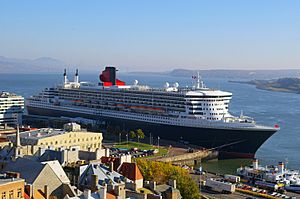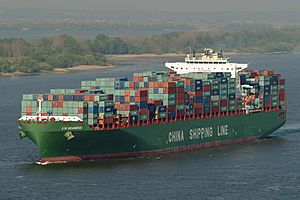Ocean liner facts for kids


An ocean liner is a very large ship built to carry people and sometimes cargo across oceans. These ships usually travel on set routes and follow a schedule, much like a bus or train. They are designed for long journeys, often crossing entire seas or oceans.
Ocean liners are different from ferries, which are smaller ships that travel shorter distances. Ferries might cross a channel, a lake, or travel between an island and the nearby coast. Ocean liners are also different from Cruise ships. While cruise ships are used for fun and vacations, ocean liners were mainly used for transportation.
For many years, ocean liners were the main way for people to travel between continents. However, since the second half of the 20th century, airplanes have largely replaced them for fast travel. Today, very few true ocean liners are still in service.
Contents
History of Ocean Liners
Early Steamships
The idea of ocean liners began in the 19th century with the invention of the steam engine. Before this, ships relied on wind power using sails. Steam power made journeys faster and more predictable.
In 1838, the Sirius was the first ship to cross the Atlantic Ocean using only steam power. This was a huge step forward. Soon after, other steamships like the SS Great Western began regular trips across the Atlantic. These early ships helped connect continents like never before.
The Golden Age of Ocean Liners
The late 19th and early 20th centuries are known as the "Golden Age" of ocean liners. During this time, shipping companies competed to build the biggest, fastest, and most luxurious ships. These liners became symbols of national pride and technological progress.
Many people traveled on these ships for different reasons. Some were wealthy tourists enjoying luxury. Others were immigrants hoping for a new life in a different country. The ships offered different classes of travel, from grand first-class cabins to more basic accommodations for immigrants.
Famous ships from this era include the RMS Mauretania and the RMS Lusitania. These ships were known for their speed and comfort.
Safety and the Titanic
The sinking of the RMS Titanic in 1912 was a major event that changed ocean travel forever. The Titanic was considered "unsinkable," but it hit an iceberg and sank, leading to a great loss of life.
This disaster led to serious changes in safety rules for ships. New rules were made about having enough lifeboats for everyone on board. Also, an international ice patrol was set up to warn ships about icebergs.
Ocean Liners During Wars
During World War I and World War II, many ocean liners were used for different purposes. They were often converted into troopships to carry soldiers across the oceans. For example, the Queen Mary and Queen Elizabeth served as troopships during World War II. They were very important for moving large numbers of troops.
The Decline of Ocean Liners
After World War II, a new way of travel became popular: airplanes. Air travel was much faster than sea travel. A journey that took days or weeks by ship could be done in hours by plane.
Because of this, fewer and fewer people chose to travel by ocean liner for transportation. Shipping companies began to focus more on cruise ships for vacations, rather than scheduled transport. By the 1960s and 1970s, most of the grand ocean liners had stopped their regular services.
Modern Ocean Liners
Today, there is only one true ocean liner still in regular service: the RMS Queen Mary 2. Launched in 2003, she continues the tradition of transatlantic crossings. She is a very large and modern ship, designed to handle the rough conditions of the open ocean. While she offers luxury cruises, her main purpose is still to provide scheduled transportation across the Atlantic.
Images for kids
-
As of 2022[update], RMS Queen Mary 2 is the only ocean liner still in service
-
The first voyage of SS Great Western (1838)
-
Isambard Kingdom Brunel at the launch of SS Great Eastern in 1857
-
RMS Britannia of 1840
-
SS Great Eastern of 1858
-
The sinking of RMS Titanic in 1912 led to a serious re-examination of safety measures at sea.
-
RMS Olympic with dazzle camouflage during World War I
-
The Queen Mary, serving as a troopship, arriving in New York in 1945
-
SS United States of 1952
-
The SS Andrea Doria sinking after colliding with MS Stockholm in 1956
See also
 In Spanish: Transatlántico para niños
In Spanish: Transatlántico para niños






















